2007 VOLKSWAGEN GOLF PLUS wheel
[x] Cancel search: wheelPage 104 of 541
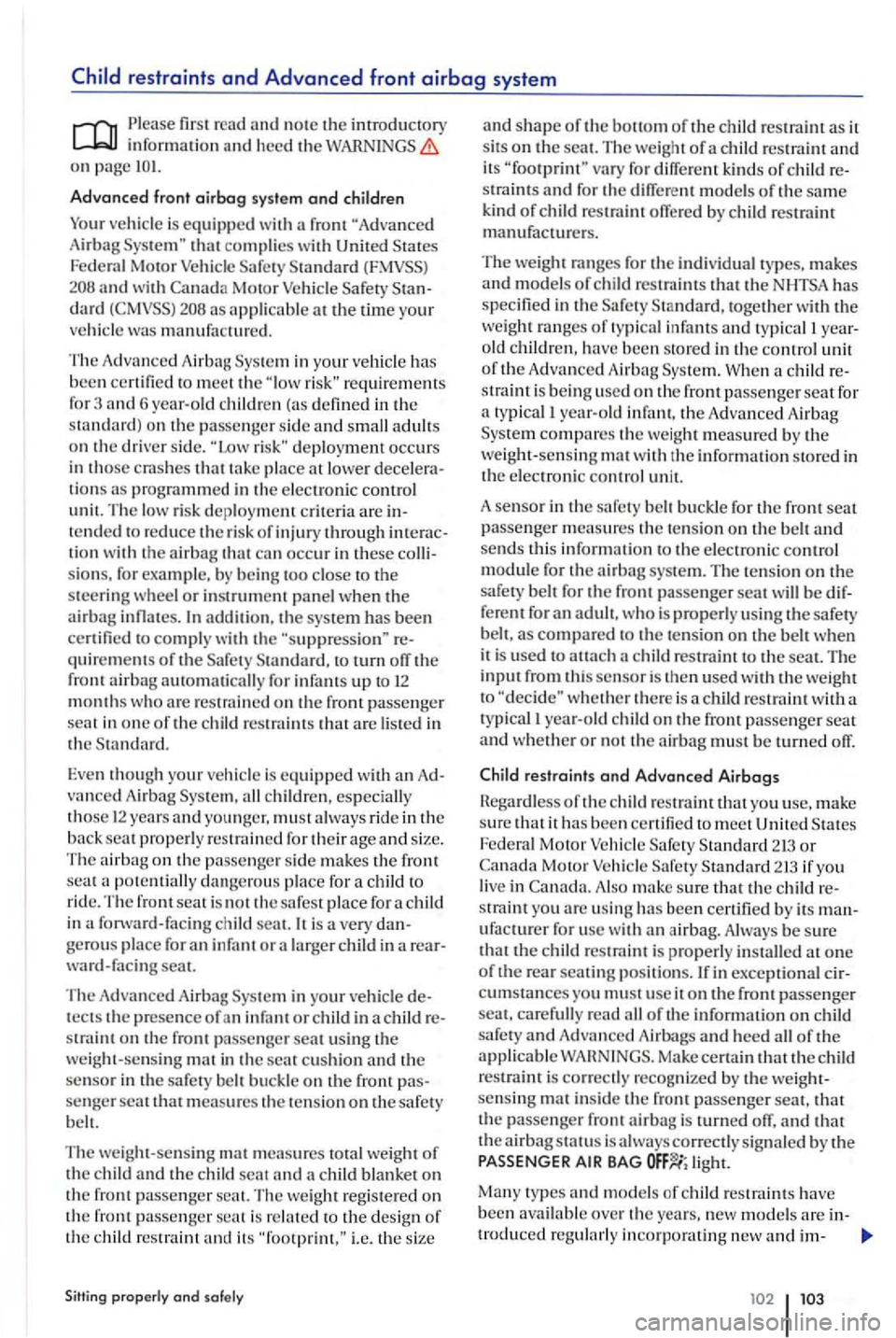
Child restraints and Advanced front airbag system
Please firs t read informatio n and heed the WARNINGS o n page
vehi cle is equipped w ith front complies with United States Federal Motor Vehicle and with Vehicle Safety dard
The Advanced Airbag requirements
for 3 and 6 yea r-old children (a s defined in the
standard) o n the passenger sid e and adults
o n th e side." Low risk" de ployment occurs
in those cras hes place at lower decelerations programmed in the e lectronic control unit. The low risk deployment c riteria are in
t e nded to reduce the risk through int eractio n with the airbag can occur in these colli
sio ns. for example, b y being too close to the steerin g wheel or in strument pan el when the airbag In addition, the system has been certifi ed to comply with the requirements of the Safe ty rd. to turn off the
f ront airbag fo r infant s up to 12 months w ho are restrained on th e front passenger seat in one of the c hild restraint s that a re lis ted in the
Airbag children, especially
those 12 years and younger. mus t a lways ride in the backseat properly re strained for their age and size. The airbag o n the passe nge r sid e makes the front scat potentiall y dangerous place for a child to
ride. The front seat is not the safest place for a child in a forward-facing child seat. la rger child in a rearward -fac ing seat.
The ,\dvanced Airb ag Syste m in your vehicle detects the presence o f a n in fant or child in a child straint on the front passenger seat using th e weight-sen sin g mat in th e scat cushion and the
se nsor in the sa fe ty be lt buckle on the fro nt passenger that measures the tension on the safet y
belt.
The weight-sen sin g measures total weight of the c hild and the child seat and
i.e. the size
pro perly ond safely
and shape of the botto m of the chi ld restraint as it
s it s on the seat. The weight of a chi ld restraint and its vary for different k inds of c hild re
straints and for the diff erent mode ls o f th e same ki nd of child restra int offered by child restraint manufacturers.
The weight ranges for the in div idual types, makes a nd models of child res traint s
the Adva nced Airbag
Syste m compares th e weight measured by the weight-sen sing w ith the information sto re d in the electro ni c cont rol unit.
se nsor in the belt buckle fo r th e front seat
pnssenger measures th e te nsion on th e belt and sends thi s information to the electro ni c control
m odule for the sys tem. The tensio n on the safety belt for the front passenger seat w ill be dif
ferent for an i s properly using the safety
belt, as
w hether th ere is a child res tra int with
restraints and Advanced Airbags
Regnrdlessofthcchild rest raint that yo u u se, make
s u re th at it bee n certifi ed to meet United States Federa l Mo tor Vehicle Standard Motor Vehicl e if you live in sure that the child re
straint yo u arc usin g been cerlifi ed b y its m anufacturer for use w ith airb ag. Always be s ure that th e ch ild restra int is properly installed at one of t h e rear seatin g position s.
of th e information on child
safety and Adva nced
that
th e passenger front is turne d off. that the is light.
Many types have been availn ble over th e years, new models are in-troduced r egularly in corporating new and im-
Page 175 of 541

Ignition key positions
Fig. 118
Please first r ead and n o te the introduc tory information and heed th e on
fig. 118
No key in ig nitio n switch : column is lo cke d.
Ig nition switched e lec trical co nsumers T he ve hicl e key b e
r emove d.
Ig nition is switched on . Th e di ese l e n gin e is pre h eated. column lock b e leased.
th e e ng in e. the eng in e start s, relea se th e ve hicl e key. released . th e ve hicle
k ey return s to
If you use the w rong key
If an unauthorize d ve hicl e key been inserted
int o the ig niti on switch , it b e removed as lows:
transmi ssion: the ve hicle key cannot b e rem oved from the ig nit ion in thi s the rel ease button on th e transmissio n
se lec to r l eve r releas e. Th e ve hicl e ke y can be re m oved.
Manual tran smissio n: out the ve hicle key.
I
mproper usc of v e hi cle keys can result in rious perso nal injury.
the key with yo u w hen yo u leave the ve hicle . The engine can be started and hicle sy ste m s su ch a s the power windows can be operated, lea din g to serious personal injury.
Neve r lea ve ch ildren , d isabled pe rsons, or anyone who cannot h elp themselves in th e hicle. The doors can be locked with the remote
control key. This could result in peo ple being trapped in the ve hicle in
be exposed to very
hi gh or very low temperatures. eat build -up in the pas senger compartment of
atures can quickl y re ach leve ls cause unconscio usness and death , to
s mall children.
Never remove the key from the ig niti on
swi tc h w hile th e vehicle is moving or rolling to a stop. The steering wheel will lock and you will
not b e a ble to steer or control th e ve hicle.
Leavi ng the key in the ig niti on fo r a long time w hen th e en g in e is no t running will drain the
v ehicle batt ery.
Page 184 of 541
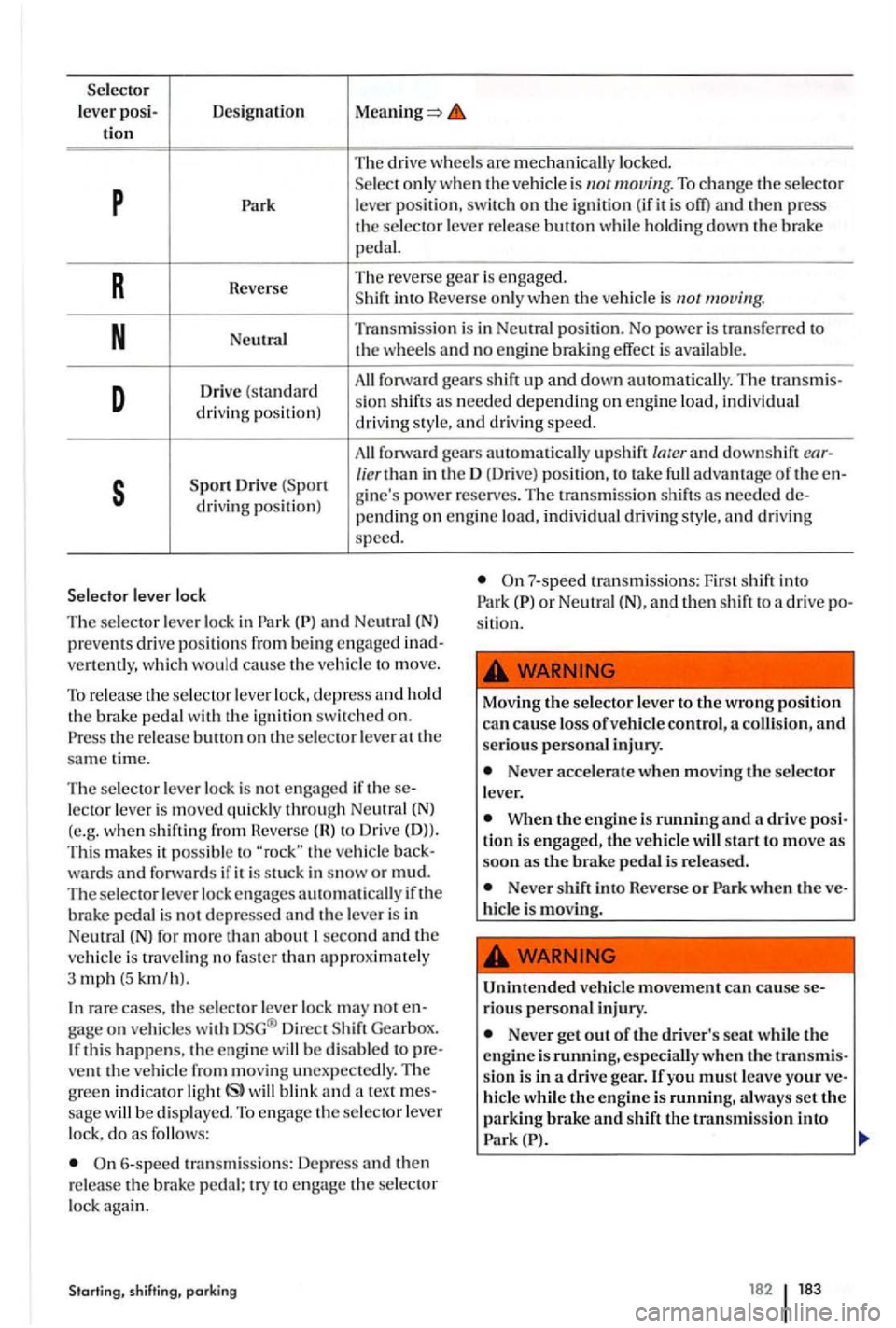
Selector lever posi- Designation tion
The drive wheels are mecha nica lly locked.
p Se le c t only when the ve hicle is
N Neutral Tran
smissio n i s in Ne utral positi on. No power is tra nsferre d to
th e wheels and no e ng in e brakin g effect is available.
D Driv e (standard All forwa rd gears shift up and d ow n automatically. The tran smi s-
dri vin g pos ition) s
ion shift s as nee ded dep endin g on engin e load , indiv idual dri vin g sty le, and dri ving speed.
A
ll f orwa rd gea rs aut omatically up shift/aterand dow nshift ear-
s Sport Dri ve
leve r lock
Th e
selector leve r lo ck in
the re le ase button on th e selec tor leve r a t th e sam e time .
Th e se lec to r leve r l
ock is no t e ngaged if these
(R) to Dri ve (D)).
T hi s makes it possibl e to
second and th e
ve hicl e is tra velin g no faste r than approx imate ly
3 mph (5 km /h).
ra re cases. the Dir ect Gea rbox. thi s ha ppens, th e eng ine w ill be disab led to pre
ve nt the vehicle from m oving unexpec te dly. Th e
gree n ind ica tor light will blink and text mes
sage will be di sp layed. To e n gage th e selec tor lever lock, do as follows:
6-speed trans missions: Depress and then re le a se the brak e pedal; try to e ngage th e se lector l oc k again.
Starting, shifting, parking
Never accelerate when m ovi ng the selector lever.
Whe n the en gin e is running and a drive positio n is engaged, the ve hicle will start to move as soon as the brake pedal is re leased.
Never shift into Reverse or
Never get out of the driver's seat whil e the engine is running, especially when the tra nsmi s
s ion is in a drive gear. lfyou m ust leave your ve
hicl e while the engi ne is running, alwa ys set the
p a rkin g brake and shift the transmi ssio n into (P).
182
Page 189 of 541

Braking, stopping, and parking
Introduction
In this section yo u'll find inform ation on fo l
lowi ng:
Warning and indicator lights . . . . . . . . . . . . . . . . . 189
Park in g brake . . . . . . . . . . . . . . . . . . . . . . . . . . . .
.. . . . . . . . . . . . . . . 19 1
About t
he brakes . . . . . . . . .. . . . . . . . . . . . .. . . . 192
Bra king assistance sys tem s . . . . . . . . . . . . . . . . . . . . 194
Switching Anti-Slip Regulation (ASR) on ond off . . 196
Brake fluid . . . . . . . . . . . . . . . . . . . . . . . . . . . . . . . . . 196
T he brakin g support syste ms are Brake A ss is t E lec tro nic Differ e n tial Loc k (EDL). Anti-Slip
M ore information:
Trail er page
pag e
Tires and page 276
acce ssories, r epa ir s and modifi catio ns
brakes or worn brake pads can
ca use colli sio n and serious personal inju ry.
light s up in the
in strument cluste r di splay, w heth er a lo n e or to
ge ther with tex t message, immediat ely conta ct an authorized Volk swage n dea ler or authorized
Volkswag en Se rvi ce Faci lity to have th e brake pad s ch ecke d and , if necessary, re pl aced.
WARNING
improperly can cause se riou s pe rso nal
injury .
Never re m ove key from the ignition switch while vehicl e is m ov ing or ro llin g to a
s top. The steering w heel w ill lock and you not be
Never park the vehicle w here the ho t ex ha ust
syste m or catalyti c convert er could ignit e flam
mabl e mater ia ls, su ch as brus h , leaves , dry grass, spilled fue l, e tc .
Always apply th e parki ng brake whe n
p a rki ng your veh icle. Imprope r u sc of th e
p a rking bra ke can se rio usly injur e you and your passe nge rs.
Never use the
e m ergency . The stopping dista n ce is muc h
longer b ec au se onl y the wheels arc braked . use the foot brake to sto p the vehicle .
Never the throttl e from
th e e ng in e
th e automati c transmission is in gear. The ve hicle will start t o move as soon the e ngine speed ev en i f th e brake is on.
Never leave childr en or anyo ne w ho canno t
h elp them se lve s beh in d in the vehicl e. They could re leas e the brak e move the gear selector leve r or shift , wh ic h could cause th e vehicle to start m ov ing. Thi s ca n lea d
to a cras h and seri ous personal injuri es.
Always take the key with you when yo u
leave th e ve hicle . The engine ca n be started and ve hicl e sys te m s s uch as the power wind ows can
b e operate d , le ad ing to seri ous perso nal injury.
Neve r leave childr en , di sabled perso ns, or a nyon e who cannot h elp them se lves in the vehicl e. T he doors can b e lo cke d wit h the re mote contro l ke y, trapping passe nge rs in the
ve hicle in an emerge ncy. For exa mpl e, dep ending on th e tim e of year, people trappe d in the
ve hicle can be ex pose d to very high or very temperatures. Heat build -up in the passenger and parked vehicl e result in temperatu res in the ve hicl e th at arc much hi gher than the outsid e tempe mtu
res, partic ul arl y in summer. T emperatures ca n
qui ckly reac h le v e ls that can cause uncon
scio usn ess ch ildr en.
Page 191 of 541

Lights cause or up
I
Together w ith indicator
m alfun ction.
T oge th
er with warning light
cause
or is opera ting.
W hen the ig nition
is sw itched on,
light s and instrument cluster text messages can cause the vehicl e to
break down in traffic and result in a collision and serious personal injury.
Never ignore warning light s or text WARN
Always stop the vehicl e as soon as it is safe to
do so.
Driving
with bad brake s can cause a collision and serious p ersonal injury .
does
not go out, or co mes on w hen driving, either the brak e fluid leve l in the reservoir is too low or there is a fault in the brake sys tem. Immediately
s top driving and get expert assista nce
response
Take the veh icle to an authori zed Volkswage n
d ealer or authori zed Volkswagen Service Fa-The ve hicl e brake s will work without
response
foot off accelerator pedal. Adapt driving to road conditi ons.
If the brake warnin g light BRAKE or co mes on at the same time as the warning light or th eABS may not be working properly. Thi s
could cause th e rear whee ls to lock up re latively
quickly during braking. Rear wheel brake lock
u p can cause loss of veh icle control. If yo u be
lieve that it is safe to do so, reduce your speed and d ri ve carefully and at low speeds to the neares t authorized Volkswagen dealer or a qual
the indicator light or does not go out , or if it comes on driving, the sys tem is not workin g properly. The vehicle can th en be stopped onl y with the standard brake s
(wi thout ABS). w ill not have the protection provides. Contact your authorized Volk
swage n dealer or an authorized Volkswagen vice Facility as soon as possib le.
lights up in the
in strument cluster display, whether alo ne or to gether with a te xt message, immediately contact an authorized Volkswagen dealer or authorized Volkswage n Facility to have the brake pad s ch ecked and, if necessary, replaced.
Note
Failure to heed warning lights or text WARNINGS can re sult in vehicle damage
Page 192 of 541
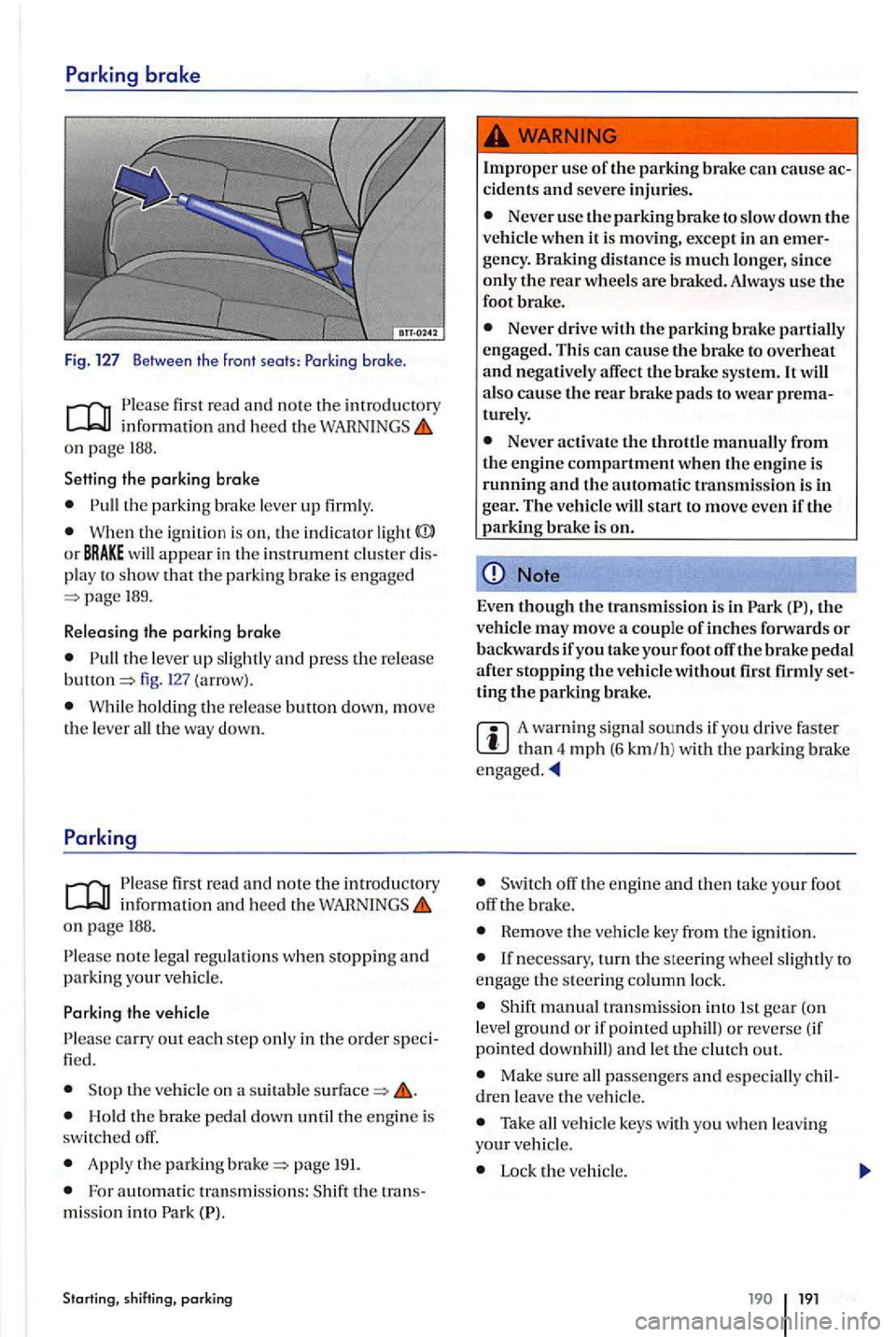
first read and note the imrod uctory
on pag e 188.
Setting the parking brake
the parkin g br ake lever up firml y.
Wh en th e ignitio n is on, the in dicator light
189.
R e leasing the parking
brake
the lever up slightl y and press the release fig. (arrow).
W hil e ho ldin g th e re lease butt on down, move
t h e leve r all th e way down.
info rmatio n and hee d th e on page 188.
n o te lega l regulations when stopping and parking your veh icle.
th e vehicle on a suitabl e
Hold th e brak e pedal dow n until the engin e is
switc h ed off.
App ly the parking page 191.
Fo r a utomatic tra nsmiss ions: th e tra ns
mi ssio n in to Park
Starting, shift ing, parking
Improper use of the parking brake ca n cause ac cidents and seve re injurie s.
Never use the pa rkin g brake to slow down the ve hicl e when it is moving , except in an emer
gency . Braking distance is much longe r, since only the rear wheels are brak ed. Always use the
foot brake.
Never drive with the parking brake partiall y
engage d. Thi s can cause the brake to overheat and negatively affect the brake syste m. It also cause the rea r brake pads to wea r prematurely.
Never acti va te t he throttl e manually from
th e e ngin e compartment when th e engine is running and the automatic tra n smissio n is in gear. The ve h icl e w ill start to move eve n iftl1 e parking brake is on.
Note
Even t11ough the transmi ssio n is in th e
ve hicl e may move a couple of inches forward s or backwar ds if you take your foot off the brake pedal after s toppin g the vehicle without set
ting tl1e parking brake.
A wa rning sig nal sounds if yo u driv e faste r th an 4 mph (6 km/h ) w ith th e parking brake
off the engin e and th en tak e yo ur foot
off brak e.
Rem ove the veh icle ke y from th e ign ition .
manual transm iss ion in to 1 st gea r (on
l evel ground or if pointed uphill) o r re ve rse (if
point ed
Make sure all passengers and esp ecially children leave th e ve hicle.
Take all ve h icle keys with you w he n le a vin g your ve hicl e.
Lock the ve hicl e.
19 1
Page 194 of 541
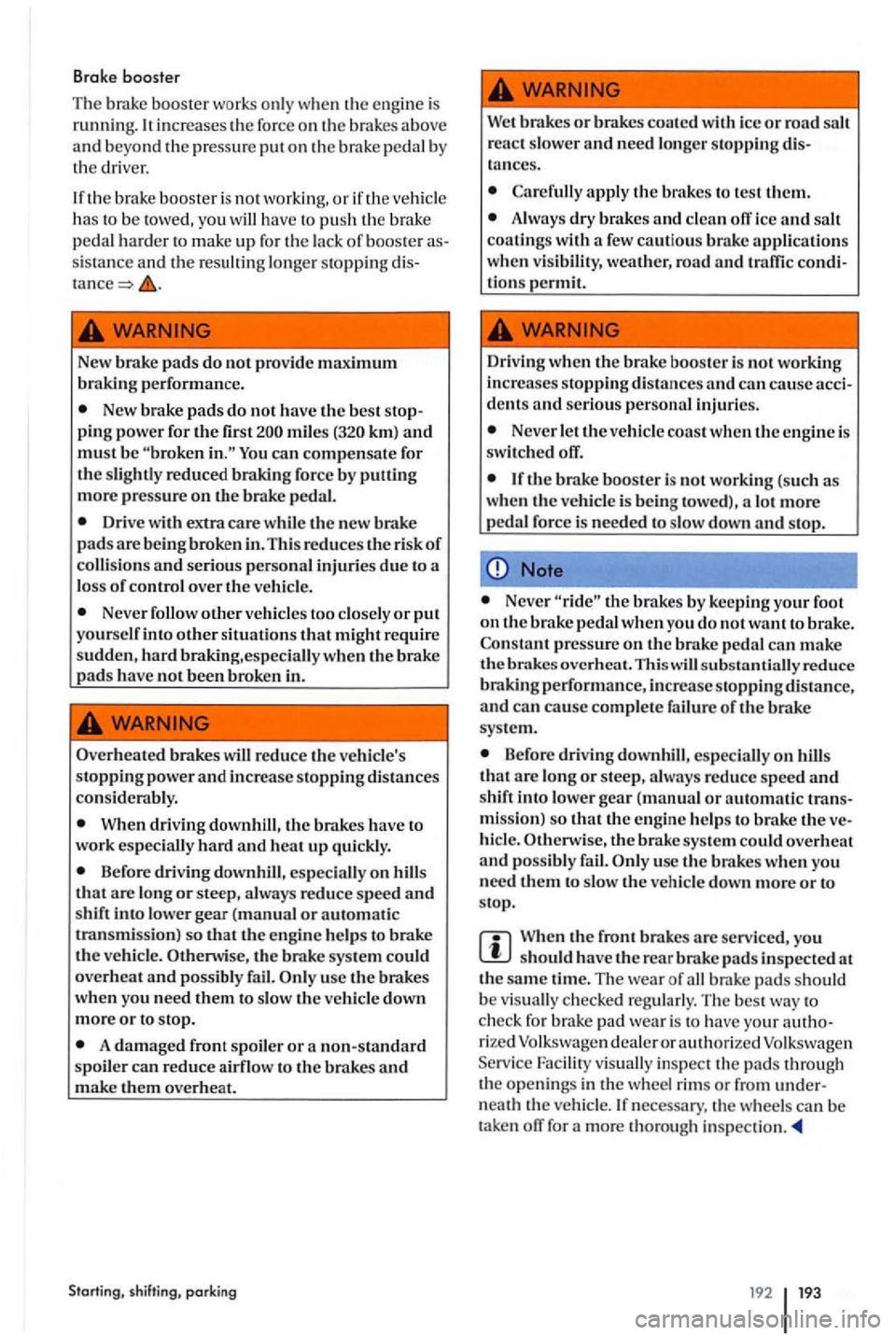
Brake booster
Th e brak e boo ste r w ork s o
nly wh en the engi ne is
running . It increa se s th e forc e on the brake s above and beyond the pre ssure put on th e brake pedal by
the driver.
If the brake booster is not working, or if th e ve hicl e
ha s to be towed, you have to push th e brak e
p ed a l hard er to make up for the lack of booster
New brake pads do not provide maximum braking performance.
New brake pads do not have the best ping power for the first km) and must be You can compensate for the slightl y reduced braking force by putting more pressure on the brake pedal.
Drive with
Never follow otl1er vehicles too closely or put yourself into other sit uation s that might require sudden, hard braking ,especially when the brake pads have not been broken
Overheated brakes
When driving downhill , the brakes have to
work es pecially hard and heat up quickly.
Before driving downhill, es peciall y on th at are long or steep, alwa ys reduce s peed and shift into lower gear (manual or automatic
transmission) so that the engine he lp s to brake
the vehicl e. Othenvise, the brake system cou ld
ov erheat and pos sibly u se the brakes
w hen yo u need them to slow the v ehicl e down
m ore or to stop.
A damaged front spoiler or a non- standard spoiler can reduce airflow to the brakes and
Starting, shifting, parking
Wet brakes or brakes witl1 icc or road salt
react slow er and n eed lo n ger stoppin g tances.
Ca refully apply the brakes to test th em.
Always dry brak es and clean off ice and salt
coat ings with a few cautious
tions permit.
Driving when the booster is no t working
in creases stopping distances and can cause dent s and seriou s personal injuries.
Never le t the vehicl e coast when the en gine is
switc hed off.
If the brake booster is not working (such as
w he n the vehicle is bein g towed), a lot more pedal force is needed to slow down and stop.
Note
Neve r the by keeping your foot on the to brak e.
Constant pressure on the brake pedal can make th e brakes overheat. This sub stantially reduce
braking performance, increase stopping di stan ce, and can cause co mpl ete failure of th e brake
s y stem.
Before driving downhill, especially on that are long or steep, always reduce speed and shift into lower gear (manua l or automati c
When th e front brake s are serviced , you should have the rea r brake pads inspected
rized Volksw agen deal er or au th orize d Volkswa gen
Service Facility vis uall y insp ec t th e pads through
th e o pe nin gs in the wh eel rim s or from nea th tl1e ve hicle. If n ecess ary, the wheels ca n be
t ake n off for a mor e thorou gh
192 193
Page 195 of 541
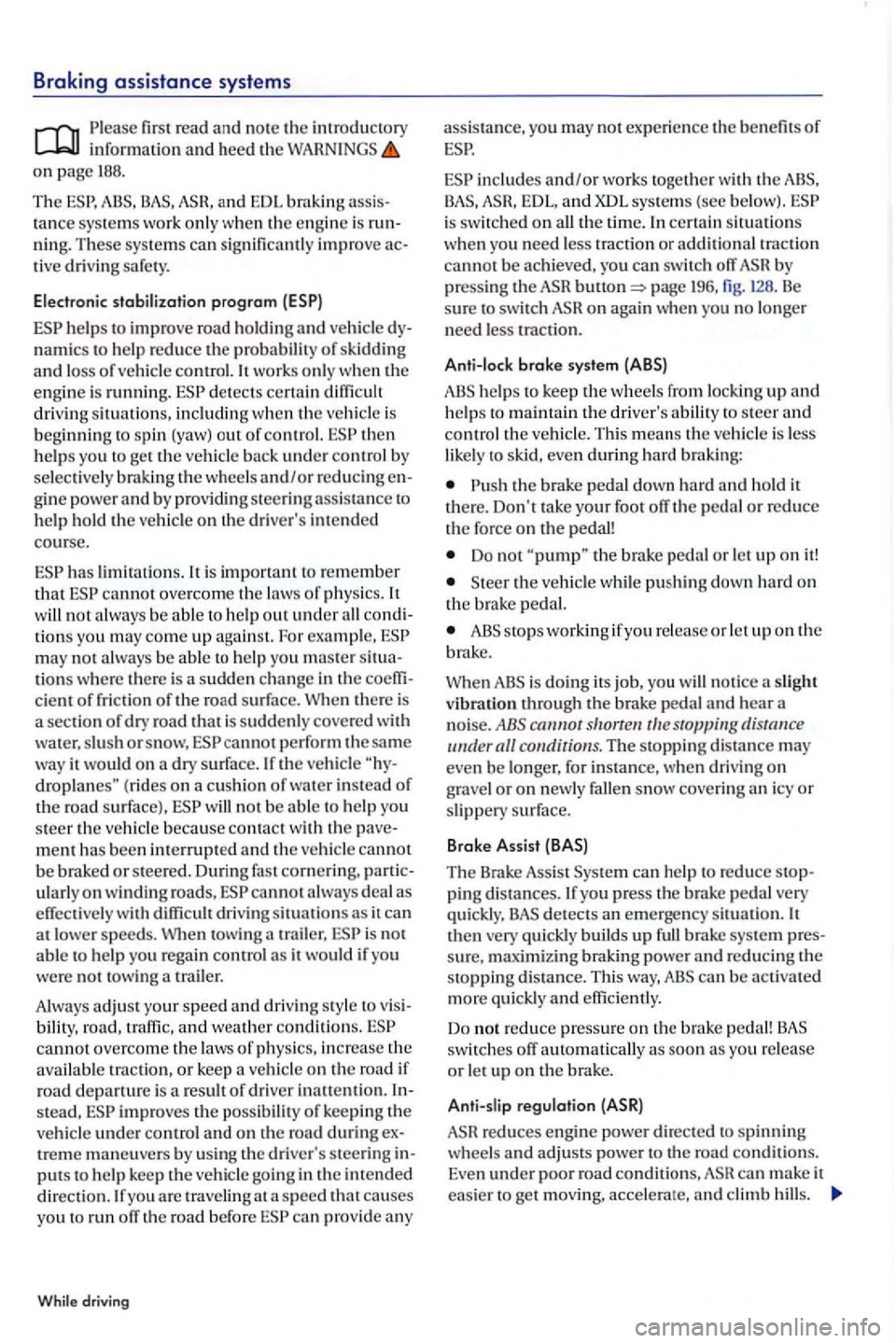
Braking assistance system s
fir st read and n o te the introductory information and heed the
on page
T he and EDL braking tance system s work onl y w he n th e engine is ning. These sys te m s can sig nificantl y improve
vehicle namics to help reduce the probability of skidding and loss o f vehicl e control. works only w hen the engine is running. driving situations, including w hen the veh icle is beginning to spin (yaw) out of control.
gin e power and by providing steering assistance to help hold the ve hicle on the driver's intended
course.
has limitation s.
will not always be able to help out under all tions you m ay come up against. For example, may no t a lways be able to hel p you mas te r tions w he re there is sudde n change in the
cannot perform the sa me
way it would on a dry surface. the vehicl e
cornering. ularly on winding road s, cannot always deal as
e ffectiv ely wi th diffi cult drivin g situations it can
a t lower speed s. When towin g a is not able to help you regain control as it would if yo u were not towing a trailer.
Alway s
adjust your speed bility, road, cannot overcome the laws of phys ics, increa se the available
stead, improves the possibil ity o f keeping th e
vehi cle under control and o n th e road during treme maneuvers b y using th e driver's s teerin g puts to help keep the vehicle going in the int ended direction .lf you a re tra velin g at a speed that causes yo u to run off th e road before can provide any
EDL , and XDL syste m s (sec be lo w). is switc hed on all the tim e. certain situati ons
w he n you need less traction or additional tract ion cannot be achieved, you can swit ch off by pressing page 196, fig. l28. B e
s
ure to switch ASR on again when you no longer
need less traction.
Anti-lock
brake system (ABS)
ABS helps to keep the wheels from l ocking up and helps to maintain t h e driver's ability to steer and control the vehicle . Thi s means the vehicle is less lik ely to skid, even during hard
th e brake pedal down hard
Do not the brake pedal or letup on it!
S teer the vehicl e while pushing down hard on the brake pedal.
ABS sto ps working if you re lease or let up on th e brake.
When is doing i t s job, you will notice
noise. T he stopping di stance may even be lo nger, for instance, when dri ving on
pin g distances.lfyou press the pedal very quickly, BAS detects an e m ergency situ ation.
pedal! BAS
s w itches off automaticall y as soon
reduces en gine power d irected to spinning wheels and adjus ts power to the road conditions.
Eve n under poor ro ad conditions,